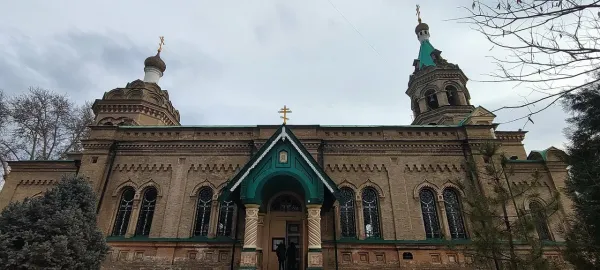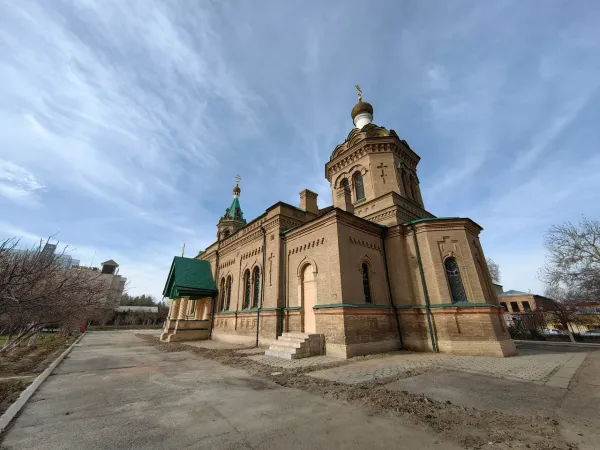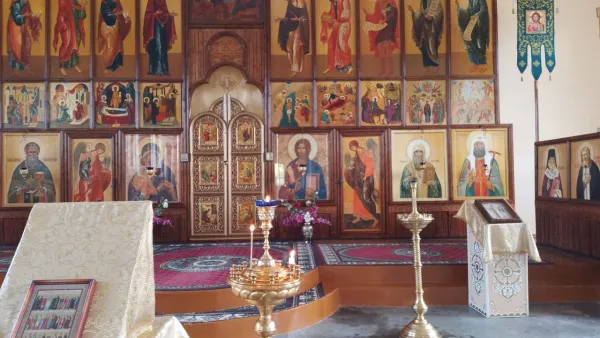Cathedral of St. Alexy of Moscow
In addition to Muslim shrines, Samarkand has several Orthodox churches built in the 20th century, which appeared on the territory after the conquest of the city by Russian troops and its incorporation into the Russian Empire. St. Alexiev Cathedral belongs to the Tashkent and Uzbekistan diocese of the Russian Orthodox Church. The cathedral was consecrated in 1912, at that time it was customary to name temples in honor of saints whose names were borne by members of the royal family. They decided to dedicate the new cathedral to St. Alexy the Wonderworker of Moscow and All Russia, because in 1904 a long—awaited event took place - the birth of the heir of Tsarevich Alexei.
The built church was originally intended for military personnel of the fifth Turkestan regiment stationed in the city of Samarkand. The cathedral was built according to a standard design, according to which all Orthodox churches of Turkestan were built inside military garrisons. According to the drawings of the same project, the church of St. Nicholas the Wonderworker in Ferghana was also built.
A part of the vestments of St. Seraphim of Sarov, a piece of the cloak of St. George the Victorious, and a piece of the holy relics of St. Nikita, Bishop of Novgorod, are kept in the cathedral.
Architecture of St. Alexius Cathedral
The cathedral building is one large, undivided hall, with side dimensions of 16 and 24 meters. The recessed altar is favorably emphasized by a light-colored dome, which visually increases its volume. An octahedral bell tower is located above the entrance to the temple. The building itself is made of pale red brick in a rather ascetic style without unnecessary decorative elements. The temple has good acoustics, and its spacious choirs can accommodate up to 60 singers.
The northern, southern and western facades have voluminous porches, the pitched roofs of which are supported by round twisted columns. The floor of the cathedral is covered with tiles made using special technology. Square cement tiles were filled with colored stone liquid mass. They resemble ceramics in their appearance.
History
After the conquest of Samarkand, military units of the Russian army were stationed in the city. To raise the level of religious and spiritual education of the troops, it was necessary to build temples, because the marching churches were bulky and could not accommodate all believers. The design of the military temple was developed, the main criteria for it were thoroughness, high capacity, and besides, it should not have taken a lot of money to build. According to this project, several churches were built in Turkestan, despite the uniform plan, all of them have individual features and a characteristic appearance.
The Cathedral of St. Alexy of Moscow was to become the main military temple of the city. Its architect was military engineer Fyodor Verzhbitsky, who made his own adjustments and adapted his design by Fyodor Smirnov. The cathedral began functioning in 1912, but the overthrow of the monarchy and the rise to power of the Bolsheviks did not have the best effect on the fate of the temple. Due to the anti-religious policy of the Soviet government, many churches were used for other purposes. So it was with St. Alexius Cathedral, the bells were removed from it, the icons were taken out and burned. Thanks to the courage of some residents, they managed to save some of them, and for a long time people hid them at home. One of these preserved icons of Italian script, depicting the Savior, was returned to the monastery after about 60 years.
The cathedral building was used for various purposes — at one time there was a dance floor, then there was a dining room, and the premises were also used as a warehouse. In the 1980s, the cathedral lost several elements of the interior, it happened during the withdrawal of the military unit, then the old alarm clock and wall candelabra disappeared. In 1990, the collection of signatures for the return of the temple to the faithful began, and the building was transferred to the church. His condition at that time was deplorable, and the heavy task of restoring the temple fell on the shoulders of the first rector, Viktor Panchenko.
In 1992, the first liturgy was celebrated, but much more had to be done to restore the monastery to its proper appearance. In 1994, Father Victor left his post, and Oleg Enin and Evgenia Konoshenko took over the work. Due to the fact that it was not possible to find sources that would shed light on how the cathedral looked inside, restoration work had to be carried out from scratch. A three-tiered iconostasis was created, the walls of the altar were decorated with ornaments, and icons were painted. In November 1996, Patriarch Alexy visited the church, who consecrated the cathedral. He presented the monastery with the altar Gospel, as well as an icon of St. Alexy the Wonderworker.
Gradually, the temple came to life and was transformed thanks to the efforts of its abbots and their assistants. The modern appearance and interior of the temple are revered by believers, the monastery does not stop there, further improvement of the territory is planned, including the construction of auxiliary buildings — a Sunday school, a dining room, guest rooms, etc.

























